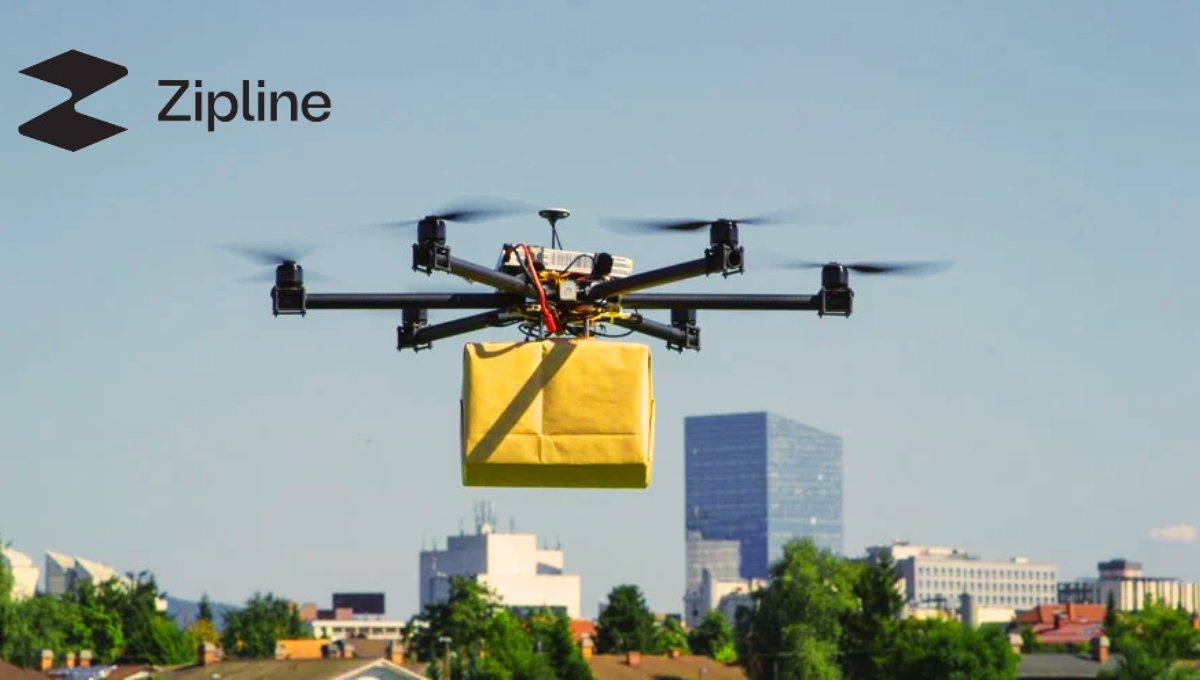People are interested in investing in Zipline because it is an innovative startup in delivery logistics using autonomous drones to address global challenges. Founded in 2014, Zipline began operations in 2016 and despite its relative youth, it has quickly completed 700,000 deliveries globally.
Rwanda was the main nation to partner with Zipline. In Kigali, the capital, residents can watch the zipline’s state-of-the-art Platform 1 (P1) drones zoom by at 60 mph, transporting vital blood supplies to remote medical facilities across the country.
A 2022 study funded by the Canadian Institutes for Health Research revealed that Rwanda successfully reduced blood loss by 67%. Credit for this improvement goes to the zipline system, which highlights the effectiveness of its service.
Initially, Zipline used the P1 delivery system, which dropped packages using simple paper parachutes. However, greater accuracy was demanded, resulting in the development of the Platform 2 (P2) system. These autonomous drones hover in place and lower a secure compartment via tether, ensuring safe loading and unloading of cargo.
Zipline adoption in the US includes major players such as Walmart and Sweet green. Walmart is currently testing P1 delivery in Arkansas, with plans to expand nationwide. Sweet Green, on the other hand, is using the P2 system.
It’s important to highlight that a significant portion of Sweet green’s 2022 revenue, specifically 32%, will come from its New York City restaurants. This partnership with Zipline could potentially bring drone delivery to the world in New York City.
In summary, what started as a zip line in Rwanda is now rapidly expanding to other countries and finding new applications. This article will look at why investing in a zipline today is worthwhile.
Is Zipline publicly traded?
As of October 2023, Zipline is still a privately held company, which means its shares are not available for trading on major stock exchanges such as the New York Stock Exchange or Nasdaq. Therefore, most people cannot directly invest in Zipline.
While Zipline has successfully raised funds through private investment, there is currently no option for a public trade. However, as the company continues to grow, existing investors and insiders may find opportunities to increase liquidity. This could potentially lead to Zipline considering going public in the future.
If you check the IPO calendar, you won’t find Zipline listed because the company has yet to announce any plans to trade publicly.
The zipline will likely go public within the next few years. They recently raised $330 million in a Series F funding round in early 2023, valuing the company at $4.2 billion.
Since Zipline is now in Series F, it has gone through multiple funding rounds. The private investors who funded Zipline needed a way to get a return on their investment, and a common way was through an initial public offering (IPO).
They may try to sell their shares in private transactions, but it may be difficult to find buyers for large stakes. Another option is for Zipline to buy back its shares from investors, but for now, it’s doubtful the company has the financial ability to do so.
Generally, companies like Zipline tend to go public, which means they offer shares to the public. This allows investors who own these shares to sell them whenever they want. So Zipline is likely to have an initial public offering (IPO) in the next few years. When that happens, everyday investors will have the opportunity to buy shares in Zipline, just like they would with any other new stock.
Of course, this all depends on the zip line being free. There’s also the possibility that another company could buy Zipline before it goes public, which is often the case.
How to buy Zipline stock
The SEC oversees investments in private companies such as Zipline, limiting the involvement of accredited investors. Platforms like Forge Global and EquityBee offer ways to acquire shares. For non-accredited investors, the most direct way to invest in Zipline is through an exchange-traded fund (ETF), which I’ll explain shortly. Alternatively, an indirect investment in Zipline can be made through shares of Alphabet (GOOG 1.44%). Goldman Sachs (GS -1.72%), and Toyota Tsusho.
1. Alphabet
Alphabet is best known for its search engine, Google, and its streaming video platform, YouTube. Not as widely recognized as its venture capital division, Google Ventures (GV), has invested in several funding rounds for Zipline. As a result, GV has a stake in the zip line. So, if you invest in Alphabet stock, you also get a stake in Zipline.
However, Alphabet, one of the largest companies globally, has a relatively small stake in Zipline. GV, Alphabet’s venture capital arm, invests in hundreds of companies, with Zipline just a small part of its overall portfolio. So, when investors buy shares of Alphabet, they have more important factors than their investment in Zipline.
2. Goldman Sachs
Like Alphabet, Goldman Sachs has invested in Zipline in several funding rounds, meaning Goldman Sachs shareholders also own a small stake in Zipline.
Similarly to Alphabet, Goldman Sachs is a large corporation with a market capitalization of approximately $100 billion. Even if Zipline becomes a big success, it’s unlikely to significantly affect Goldman Sachs shareholders. Investors interested in Goldman Sachs should focus primarily on its core business operations.
3. Toyota Tsusho Corporation
Toyota Tsusho Corporation, a prominent Japanese conglomerate, has not only invested in Zipline but also uses its services as a customer. In the remote Goto Islands in southwest Japan, Toyota Tsusho collaborates with Zipline to deliver essential medical and pharmaceutical supplies using autonomous drones.
Toyota Tsusho Corporation is listed on the Tokyo Stock Exchange, making it accessible to investors interested in international stocks. However, for US citizens, investing in foreign exchange involves different procedures than buying stocks on US exchanges. Anyone considering this route is advised to consult a financial professional to fully understand the specific requirements and associated risks. Now, let’s explore the step-by-step guide to buying stocks.
Here’s a straightforward step-by-step guide on how to buy stocks.
Step 1: Open a brokerage account
For US investors looking to buy stocks on a domestic exchange, the process is now much easier. It starts with opening a brokerage account, which has become more accessible and cost-effective than in years past. Sincere, known for its wide range of investment services, is a popular choice among many investors, but there are other reputable online brokerages.
Step 2: Figure out your budget
Once you have set up a brokerage account, the next step is to decide on your investment budget. This is a personal decision and no one size fits all. As a rule of thumb, it is advisable not to invest money that you will need in the next five years. Stocks can be unpredictable; their value fluctuates, and if you need the money during a market downturn, you can sell at a loss. It is important to consider your financial situation and investment goals before committing funds.
Step 3: Do your research
Once you’ve established your budget, the next step is to research stocks. During this process, it is important to weigh the potential risks against the opportunities for benefits.
Once you have done thorough research, you can proceed to purchase stocks. Each brokerage may have its own specific procedure, but in general, you’ll enter the stock’s ticker symbol and specify the number of shares you want to buy. Some brokerages also offer the option to invest in fractional shares, allowing you to specify the exact dollar amount you want to invest instead of the number of shares. This flexibility can accommodate a variety of investment strategies and financial goals.
Is Zipline profitable?
Zipline operates as a private company, meaning it is not obligated to share its financial details publicly. From what can be deduced, this is probably not doing any good.
Private companies like Zipline typically prioritize expanding their operations over immediate profit maximization, a strategy that aligns with the goals of venture capital investors. These investors have invested substantial funds in Zipline, aiming to fuel its rapid growth. They encourage the company to focus on scaling without being overly cautious about short-term profits.
Should I invest in Zipline?
The autonomous last-mile delivery market is expected to grow at an impressive 24% compound annual growth rate (CAGR) through 2030, surpassing $90 billion in 2022, according to a report by Allied Market Research. year, the positioning of the zip line is favorable to take advantage of this expansion. Zipline stands out with its potential competitive edge in domestic autonomous drone delivery, particularly given the Federal Aviation Administration’s (FAA) regulation of US airspace.
Zipline achieved a milestone in 2022 by becoming the first company of its kind to receive approval for long-range drone delivery operations, underscoring its leading role in the industry.
While Zipline operates internationally, its expansion into the U.S. is critical to its plans. Getting approval from the FAA is an important milestone as the company moves forward. Management aims to significantly increase its annual flight volume, aspiring to overtake major airlines by 2025, marking an ambitious target for growth.
There are great reasons to be optimistic about Zipline’s future. However, like any business endeavor, there are inherent risks involved. A key threat is competition. Amazon, which is well-funded and has been exploring autonomous drone delivery for years, poses a notable competitive challenge to Zipline.
It’s important to understand that Zipline’s operations extend beyond its drones. The company also manages distribution centers and develops logistics software to ensure seamless operations. In contrast, Amazon has a strong reputation for its efficient distribution centers and advanced software capabilities. That advantage could potentially keep Amazon ahead of Zipline as the autonomous last-mile delivery sector continues to grow.
Investing in stocks is naturally uncertain because the future is difficult to predict. The same applies to Zipline: while it has avenues to create value, there are also potential obstacles that could hinder its growth. Investors should carefully evaluate the potential rewards as well as the risks to decide whether an investment is consistent with their financial objectives and risk tolerance.
ETFs with exposure to Zipline
Most of Zipline’s funding has come from venture capital investments. A notable opportunity for retail investors is the ARK Venture Fund, managed by Kathy Woods of ARK Invest, which aims to make venture capital more accessible to a wider range of investors.
Arch Venture Fund holds a mix of publicly traded and private companies in its portfolio. Zipline, in particular, holds the fifth-largest position within the fund, accounting for 4.34% of its total investments. Although the fund is accessible to non-accredited investors, a minimum investment of $500 is required to participate.
If you are considering investing in such a fund, it is important to carefully review all relevant documents first. Keep in mind that this is an actively managed fund, which generally means that its fees may be higher than other funds. These fees can reduce the fund’s potential returns, so it’s important to fully understand them before making your investment decision.
Conclusion of Zipline
Zipline uses autonomous drones for worldwide deliveries, experiencing rapid growth and poised to capitalize on prevailing industry trends.
Investing in Zipline offers both direct and indirect investment opportunities. However, since not all relevant information is currently publicly available, it may be difficult to evaluate this as an investment opportunity. Additionally, potential investors need to consider these key challenges before deciding to invest in a zip line.
FAQs: Investing in Zipline FAQs
Will Zipline stock go public?
The zipline is likely to go public in the future. However, as of October 2023, the company has not made any official announcement about its plans to do so.
Is the Zipline company profitable?
Zipline operates as a private company, which means it does not disclose its financial details to the public. Typically, private companies like Zipline prioritize growth over profits in their early stages, which suggests that they are currently reporting annual net losses.
Who owns the company Zipline?
Zipline is owned by insiders and investors, including firms that specialize in venture capital.
How do I invest in pre-IPO shares?
Accredited investors have the option to purchase Zipline’s pre-IPO shares through platforms that specialize in private company investment trading.
Can you invest in the Zipline company?
As of now, Zipline is a privately held company, so direct investment in its stock is limited to accredited investors through private investment platforms.
How do I buy shares in Zipline?
Currently, Zipline shares are not publicly traded on major stock exchanges such as the NYSE or Nasdaq. Accredited investors may find opportunities to purchase shares through private markets or investment platforms that specialize in private company investments.
Who has invested in Zipline?
Zipline has attracted investment from a variety of sources, including venture capital firms, strategic partners, and potentially large corporations that see value in its innovative drone delivery technology. Notable investors include institutions such as Alphabet (Google), Goldman Sachs, and Toyota Tsusho, which have supported Zipline’s development through funding rounds.
Does Zipline have stocks?
Zipline is currently a privately held company, so it does not have publicly traded stock available for purchase on stock exchanges.





